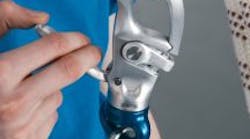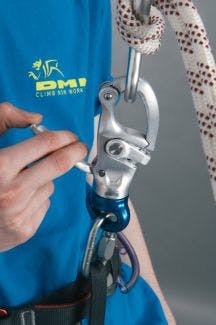Ten for STEM - Ten developments promoting science & technology learning
Education in the area of science, technology, engineering, and mathematics (STEM) has been in the headlines as employers find it tough to uncover potential employees having STEM backgrounds. Efforts are underway to rectify perceived shortages in STEM fields. Notice of several such initiatives recently crossed our desk. Here is a quick update on what's going on:
Metalworking scholarhsips: The National Institute for Metalworking Skills (NIMS) and the Gene Haas Foundation (GHF) have collaborated on the GHF-NIMS Credentialing Scholarship Program which will provide secondary and post-secondary institutions with grants to build high-quality technical programs. The Scholarship Program is launching with a $100,000 contribution from the GHF. The program aims to help find people who can fill an estimated 99,500 projected job openings for machinists and 117,100 projected job openings for industrial maintenance technicians through 2020.
The Scholarship Program officially kicked-off at the 2014 SkillsUSA National Leadership and Skills Conference in Kansas City, where technical education students compete in hands-on skill tests. All competitors in the Precision Machining Technology, CNC Milling and CNC Turning programs will be the first to participate in the program, receiving scholarships to earn NIMS’ Level I Machining credentials.
Women in STEM in the UK: Recently a charity called Construction Youth Trust and UK high-speed rail organizer HS2 Ltd ran a special female-only course to inspire young students interested in STEM subjects about careers in engineering. Called Budding Brunels, the program targets students from schools where a high percentage of them are on free school meals. City University London's Widening Participation Dept. hosted 26 young women who spent the day with female volunteers from HS2 Ltd. who talked about their careers in engineering and what inspired them to take their particular career path.
Among the activities: students competed to build the tallest tower out of marshmallows and spaghetti. The HS2 Ltd volunteers also supported an activity encouraging students to design their own railway line taking into consideration factors such as communities, environment and cost.
Better way to teach engineering: Purdue University researchers think they've come up with a way of more effectively teaching large numbers of engineering students. The system, called the Purdue Mechanics Freeform Classroom, lets students interact with each other and faculty online while accessing instructional videos and animations. System creator and Purdue ME professor Charles Krousgrill says the idea has already significantly reduced the number of students who receive a grade of D; or drop, fail or withdraw from engineering courses. The system includes highly interactive course blogs and has been tried for five semesters in basic mechanics and seven semesters of a follow-on course.
Students get "Best Paper" awards: For the first time, two students got Best Paper honors at RadTech 2014, the biennial conference for ultraviolet and electron beam technologies. Bradley Tuft, a chemical engineering student at the University of Iowa won the best paper award for "Photopolymerized Patterning and Materials to Enhance Neural Prosthetic Performance," which demonstrates the use of UV to generate physical micropatterns in biomaterials and the first use of topographic cues to align neurites of neurons from the inner ear that may be used in cochlear implants.
Christian Gorsche and colleagues, of the Vienna University of Technology, received the best Student Paper honor for "Recent Advances in Monomers and Photoinitiators for Dental Restoratives." The paper presented a promising new generation of filling materials based on the element germanium that allows for faster and easier dental treatments.
Student design is a life saver: Brunel University student Samuel Harris’s final year project – a life-saving quick release device – went on display at a prestigious exhibit in the UK recently. Harris devised the system after successive news stories about rescue divers becoming trapped by their own lifelines and drowning. A simple tug of a locking pin and a push of a lever on Harris' restraint system lets divers extricate themselves.The device has undergone dynamic, static and user testing to ensure the user can entrust their life to it. Harris says he's gotten a lot of interest from the military because the system acts as a safety device when special forces fast-rope down from a helicopter. He says other safety devices take up to 20 seconds to release whereas the release time on his device is a fraction of a second.
Student UAV competition: Students from Virginia Commonwealth University School of Engineering were among those competing against 40 other universities trying to design the best Unmanned Aerial System (UAS). The Association for Unmanned Vehicle Systems (AUVSI) Foundation has has hosted the competition since 2002.
The SUAS competition allows any kind of UAS able to reach a flight ceiling of 100 feet. The goal this year was to make an autonomous plane capable of visually identifying markers and relaying information back to a ground-control station. The competition, meant to simulate the stress and dangers of a real life mission, gives each team only 30 minutes—from takeoff to landing—to achieve the course's goals. Last year, teams competed to find as many ground targets as possible, as well as locating bonus barrels, and decoding a secret message embedded in targets. In previous years, the teams' Unmanned Aerial Systems dropped payloads simulating distributing rescue supplies during a natural disaster.
FIRST LEGO League: More than 500 FIRST LEGO League teams across the globe submitted inventions for theFIRST LEGO League Global Innovation Award, presented by XPRIZE. Teams made up of 9 to 16 year-olds were asked to explore natural disasters and develop innovative ways to mitigate the effects of these events. The winning team received a cash award of $20,000 and the two runner-up teams each received $5,000.
The big winner was something called the Balloon-Based Notification Sign from kids in Sherborn, Mass. It indicates where to find aid after a natural disaster, when traditional infrastructure is not available. The large sign is suspended from a helium balloon that can be seen from long distances. A runner-up called the Cyclone Survivor Board Game hailed from Williamsburg, Iowa. It is a board game that uses federal and local information to educate players on how to prepare for, survive and recover from a tornado. The object of the game is to collect miniature emergency gear to place in the player’s emergency kit.
Finding Formula One engineers: Infiniti has named 12 budding hopefuls who will participate in the world finals of the Infiniti Performance Engineering Academy. The finalists will compete to win the work placement of a lifetime - a 12-month engineering role with Infiniti Red Bull Racing, complete with accommodation in the UK, Infiniti company car and full salary. Out of 1,500 international engineering students from over 100 universities, the final 12 include nine men and three women made up of four Americans, three Chinese, two Australians, one British, a Malaysian and a Sudanese.
Finalists will next attend a three-day shootout event in the UK before the British Grand Prix, taking place at Infiniti’s European Technical Center at Cranfield and at Infiniti Red Bull Racing’s factory in Milton Keynes. There they will face a series of intensive interviews, practical tests and technical challenges, closely assessed by leading technical figures from Infiniti and Infinti Red Bull Racing. The three winners will be unveiled by Infiniti Red Bull Racing’s Chief Technical Officer Adrian Newey on July 3rd.
Power grid for kids: Automation equipment supplier ABB and Marbles Kids Museum put together a play-based power grid exhibit, called Kid Grid, to generate interest in science, technology, engineering and math among young children. Located in Raleigh, N.C., the museum was funded by a $1 million grant from ABB. It introduces youngsters to electricity and power grid technology through hands-on, minds-on play. Kids explore a pretend power grid and learn how to make smart energy choices.
ABB employees and families collaborated with Team Marbles during initial design, brainstorming creative ways to get kids talking about energy. Engineers and experts from ABB continued to provide guidance and knowledge throughout design and construction to ensure Kid Grid accurately reflects a real power grid. Kid Grid is complete with play versions of cables, control systems, motors, towers and transformers as well as real equipment provided by ABB.
Automotive engineering challenge: Automotive supplier Valeo will kick off its second annual global innovation contest, called the Valeo Innovation Challenge, this fall, wherein engineering students from around the world will compete to win a €100,000 grand prize. The idea of the challenge is to create equipment that will make cars more intelligent and intuitive by 2030. Valeo will announce the terms and conditions of this year’s contest at the 2014 Paris Motorshow.
Comprising teams of two to five people, engineering students can take part by presenting a relevant, innovative project on the contest website. The aim is to stimulate creativity, enabling students to form multidisciplinary teams, perhaps with students in the social sciences or other scientific disciplines that might be useful for the innovation project. Then 20 shortlisted teams will be asked to create a model in the format of their choice (physical mock-up, application or other). Each team will be given €5,000 to put their idea into practice and build a functioning demonstrator.

